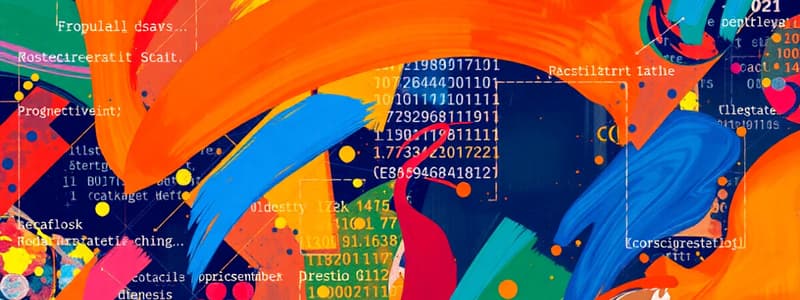Podcast
Questions and Answers
What is the purpose of an algorithm?
What is the purpose of an algorithm?
- To display diagrams of steps and decisions
- To define variables and data types
- To solve problems with computer assistance (correct)
- To describe programming syntax
What does a flowchart represent?
What does a flowchart represent?
- A method for defining constants
- A detailed code description
- A sequence of programming instructions (correct)
- A diagram of steps and decisions in a program
What is pseudocode used for?
What is pseudocode used for?
- Managing variables in memory
- Describing programming algorithms in a simple way (correct)
- Executing program instructions directly
- Compiling source code
What is the function of an identifier in programming?
What is the function of an identifier in programming?
What is a constant?
What is a constant?
What is the purpose of a variable?
What is the purpose of a variable?
In programming, what is the term for providing data to a program?
In programming, what is the term for providing data to a program?
What is an operand?
What is an operand?
What is the purpose of the IF statement in programming?
What is the purpose of the IF statement in programming?
What does a While statement do?
What does a While statement do?
Flashcards
Algorithm
Algorithm
A method consisting of structured and systematic steps to solve problems with computer assistance.
Flowchart
Flowchart
A diagram that displays the steps and decisions to carry out a process in a program.
Pseudocode
Pseudocode
Pseudo-code can be interpreted as a description and programming algorithm written more simply compared to programming language syntax.
IDE
IDE
Signup and view all the flashcards
Identifier
Identifier
Signup and view all the flashcards
Constant
Constant
Signup and view all the flashcards
Variable
Variable
Signup and view all the flashcards
Input/Output
Input/Output
Signup and view all the flashcards
Operand and Operator
Operand and Operator
Signup and view all the flashcards
IF statement
IF statement
Signup and view all the flashcards
Study Notes
- Algorithms consist of structured, systematic steps to solve problems with computers.
- Flowcharts are diagrams depicting the steps and decisions in a program.
- Pseudocode can be interpreted as a description and programming algorithm that is simpler than programming language syntax.
- A text editor and compiler can be separate or combined.
- A combination of a text editor and compiler is called an IDE (e.g., Dev C++, CodeBlocks).
- Identifiers are names used in programming to denote variables, constants, data types, and functions.
- Constants are containers for values, and their values remain fixed throughout the program's execution.
- Variables are specially named locations for storing specific data, which can be changed during the program's execution.
- Input, also known as the "insert operation", involves entering a command of data onto the display; output displays processed data on the screen.
- Expressions use operands and operators; operands are original values, while operators instruct how to process them.
- The IF statement is a conditional statement that allows the manipulation of a program's flow.
- The WHILE statement is a loop statement that repeats commands as long as a conditional expression remains TRUE.
- A "for" loop is a repetitive control structure that lets you efficiently write loops intended for many specific repetitions.
- A function is a code program designed to complete a specific task and is part of the main program.
Studying That Suits You
Use AI to generate personalized quizzes and flashcards to suit your learning preferences.




